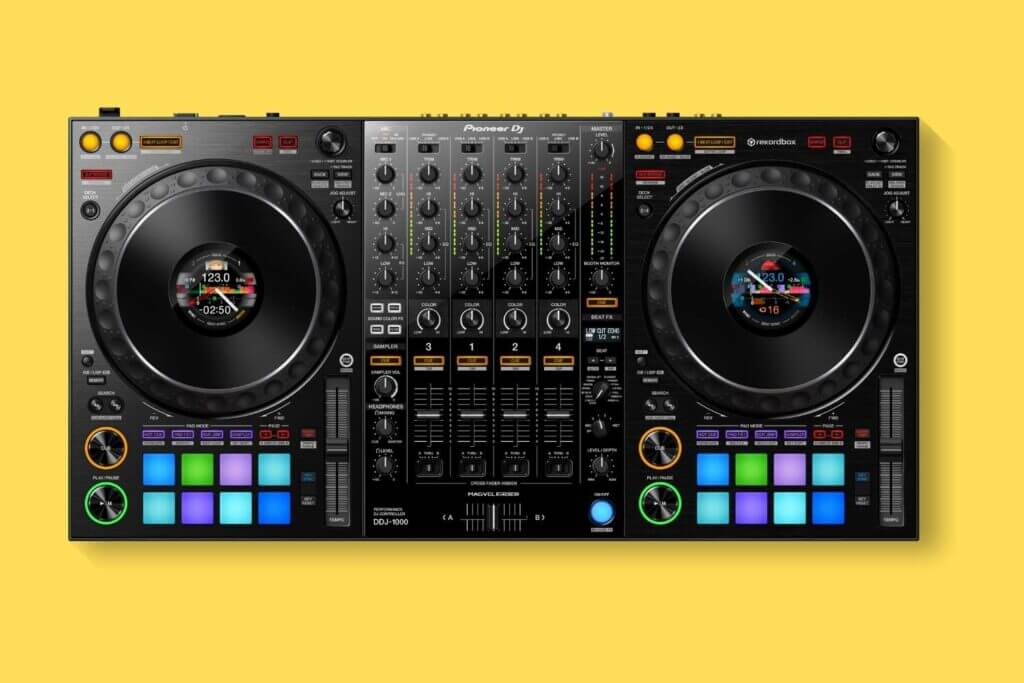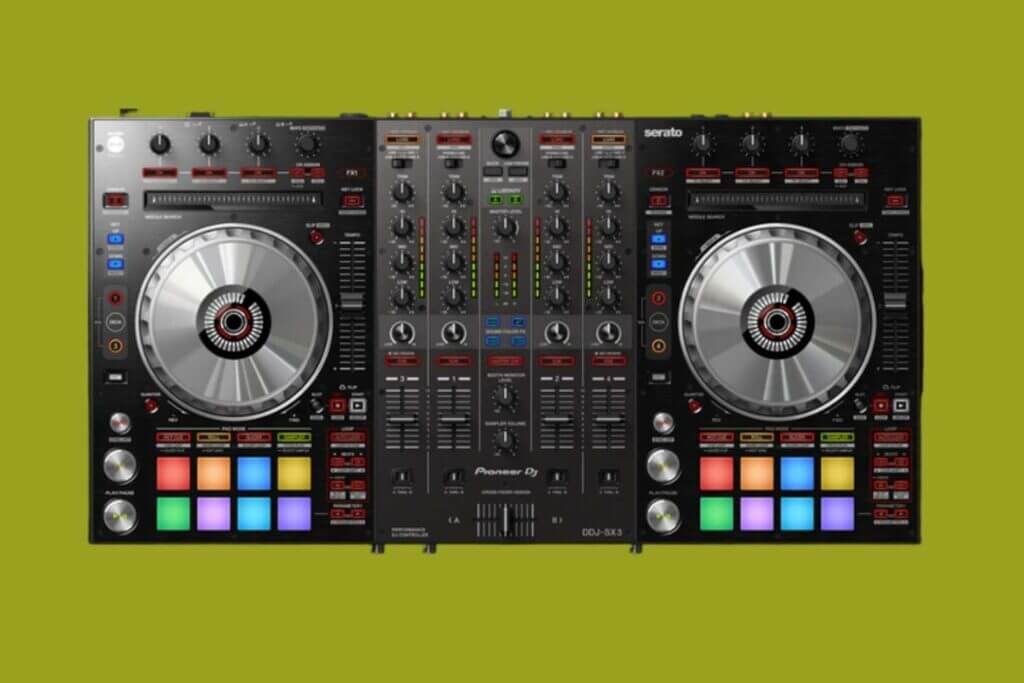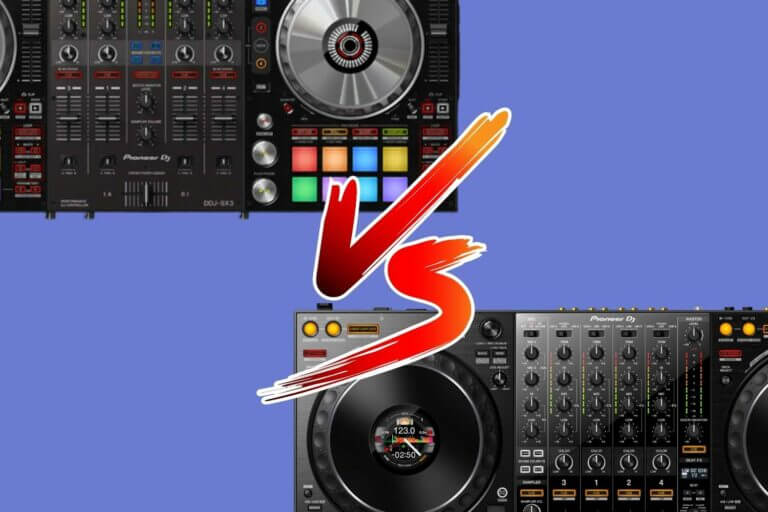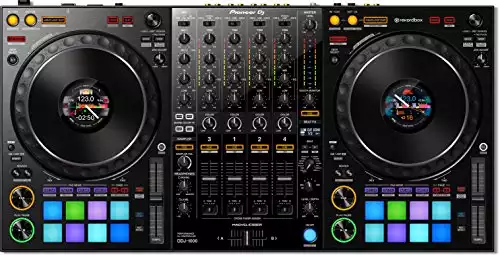Pioneer DJ’s two power player controllers go against each other.
If there’s one thing you have to know about Pioneer DJ as a company, it’s that they rarely do things halfway. Whether we’re talking about the general quality of the hardware, the different features of the software, or any other part of the DJ equipment, the company makes a point of being at the top of its game virtually all of the time.
It’s the reason why they’re by far the number one option compared to just about any other DJ-based platform out there.
Pioneer DJ DDJ-1000SRT Vs DDJ-SX3: Overview
Off the many different DJ controllers produced by the company, two stand out as being particularly impactful, both for their respective brands but also for the DJ landscape as a whole – the DDJ-1000SRT and the DDJ-SX3.
Depending on when you first got into the DJ space, you may or may not know about either of these incredible controller options.
Both, the 1000SRT and the SX3 have made huge waves in the DJ controller space that are felt even to this day. Not only that, they both share many of the same features and are comparable in the overall price.
That said, they aren’t the same nor are they necessarily equal in terms of overall quality. In this comparison guide, we’ll take a look at both controllers’ relative strengths and weaknesses as well as some of the overall similarities between the two.
By the end, not only should you have an idea of which of the two is objectively better than the other, but also which controller is most ideal for you and what you are looking to do as a DJ.
So, with that out of the way, let’s jump into both of these controllers.
Pioneer DJ DDJ-1000SRT Explained
Starting with the younger of the two, the DDJ-1000SRT has been and continues to be one of the hottest and most talked about controllers out there.
Simply put, it and the standard DDJ-1000 made a lot of DJs very, very happy.
The controller weighs around 13lbs (6kg) and has a width of 27.8 inches (708mm), a height of 2.88 inches (73.4mm), and a depth of 14.22 inches (361.4mm).
While technically an offshoot of the original DDJ-1000, the DDJ-1000SRT is more of a slightly varied clone than anything else, the only real difference being the transition from Rekordbox software to Serato Pro DJ software.
The controller comes with a pretty extensive number of benefits, ranging from its club-style layout, its impressive jogwheels and jog wheel display, as well as the many different FX and features available.

Read this next: Pioneer DDJ-1000SRT: Best Serato Controller Ever?
What We Like:
- Quality Build & Layout Setup
- Impressive Jogwheels
- Extensive FX Options
- Mic Input Independence
Quality Build & Layout Setup
True to most Pioneer DJ controller devices, the DDJ-1000SRT is as hardy and durable as it is lightweight and responsive. From a build quality perspective, it’s clear from the moment you play with the controller that the money invested in this device was well spent.
I wouldn’t recommend hard drops or anything exceptionally crazy, no. I would however imagine most regular life events shouldn’t have too much of an issue.
From the layout side of things, the controller is meant to follow a more CDJ style, with looping controls located above its respective jogwheel.
The controller also includes a large standalone mixer that can be used alongside an alternative set of turntables or CDJs (thanks to its 4 available channels).
Impressive Jogwheels
In addition to the controller’s overall layout being high quality, so too are its respective jogwheels. Here, these full-size 8-inch jogwheels are made mechanical-style and each has an LCD high-def screen in their respective centers.
These display screens cover playback time and position as well as BPM and several other functionalities.
Physically, both of these jogwheels feel great to the touch and, while not on the same level as particularly high-end controller jogwheels, have excellent tactile and a great amount of tug.
Extensive FX Options
The DDJ-1000SRT is fairly well known for its different effects and features. Not only does it have many of the standard FX options that most controllers may have (Pitch, Filter, Dub Echo, and Noise), but also several others.
For example, the in-built “Beat FX” is included in the controller despite many of these features often being on more expensive club mixer devices (such as Delay, Spiral, or Reverb).
Mic Input Independence
Lastly, a bit of a smaller point in the SRT’s favor, the controller includes 2 microphone inputs that each have their respective channel to access entirely independent from one another.
This means you won’t need to share channels or a universal volume control setting, but can instead run everything as it was originally meant.
What We Do Not Like:
- Serato Not A Native Inclusion
- Mic Input Isn’t As Precise
- Layout Isn’t Quite Serato-Traditional
Serato Not A Native Inclusion
While both controllers utilize Serato DJ Pro software, only one of them was built with the software natively in mind, and that’s not the SRT. As mentioned earlier, the DDJ-1000SRT was built as an offshoot of the original DDJ-1000.
With the original initially being made to handle rekordbox, this alternative version treats the Serato software replacement as more of a forced alteration instead of an innate inclusion.
This all simply means that, while compatible with Serato DJ Pro, it is much more of a tack-on situation, making some of the Serato-only features unavailable.
Mic Input Isn’t As Precise
Another point to keep in mind is that, while the microphone inputs are independent of one another, that doesn’t mean they are going to be quite as precise in terms of their EQ control.
This is because the EQ controls are shared, meaning that both will raise or lower without deviation. This results in a uniform sound even when you want it a bit more dynamic.
Layout Isn’t Quite Serato-Traditional
Lastly, another small point to finish out on, the DDJ-1000SRT’s layout, while great and very appealing for club DJs, does miss out on much of the more traditional Serato layout structure.
Again, this can be tied back to the controller being built and designed initially as a Rekordbox partner device, only being fitted with Serato after its initial success.
Verdict
The Pioneer DJ DDJ-1000SRT is a great controller with a ton of things favorable for it even now. The device, however, isn’t perfect and its origins as a non-Serato device certainly hurt it in parts.
All in all, I’d consider holding back if you are particularly interested in a Serato tried and true device since this does miss out on a lot, and technically isn’t that.
If, however, you just want a great controller that works incredibly well, the 1000SRT is the controller to beat.
Pioneer DJ DDJ-SX3 Explained
Put out on the scene before the DDJ-1000 or 1000SRT, the DDJ-SX3 was another killer innovative controller that helped usher in a ton of different features that we all take for granted today.
This was especially true at that time when its predecessor was the SX2.
The controller weighs around the same as the 1000SRT at 13.44lbs (6.1kg) while its height stands at 26.1 inches (664mm), height is 2.77 inches (70.4mm), and depth is 13.9 inches (354.4mm).
The older controller still brings a lot to the table with 3-mic inputs and enhanced sound quality, a more traditional Serato-style layout, a low-latency jog wheel design, and native compatibility with Serato.

Read this next: Pioneer DDJ SX3 Still A Great Competitor?
What We Like:
- Traditional Serato Layout
- Low-Latency Jogwheel Design
- Native Serato Compatibility
- 3-Mic Input & Enhanced Sound
Traditional Serato Layout
Starting first with the controller’s layout, the SX3 makes a point of being a more traditional and in-line Serato-based controller. This is seen in how the performance pads are placed on the deck.
The other way this is observed most clearly is in the way the SX3 has Serato DJ Pro’s effects readily available on the controller itself, making a certain option super quick and super easy to access.
Neither of these functions is available with the 1000SRT, showing that this is certainly the ideal option for those looking for an “authentic” Serato-based design.
Low-Latency Jogwheel Design
Another area that is strongly in the controller’s favor is its jogwheel setup. Here, the SX3 uses a capacitive jogwheel that is more commonly used with most controllers, especially at the time the SX3 came onto the scene.
In addition, the jogwheels are not only more common and accessible but they are also presented at a lower latency. This makes for a smoother scratching experience compared to many other controllers.
The SX3 includes illuminated scratch cue points as well as cue countdowns to play without always needing to look at your laptop.
Native Serato Compatibility
Unlike the 1000SRT, the SX3 was built with the Serato software in mind. This leads to more than just including Serato DJ Pro on the controller. Here, you’re able to access all of Serato’s features (provided you’ve paid any additional costs).
Not only that, but as was mentioned earlier, the SX3 has several of these features already available on the controller itself as an onboard effect.
You’ll also run into fewer problems going through things on your laptop or operating the software in general.
3-Mic Input & Enhanced Sound
Whereas the 1000SRT includes only 2 mic-in inputs, the SX3 offers 3. This means that you can have 3 people performing at the same time.
Not only that, but with its 3-band EQ, you can also have a more enhanced and improved sound via its low-cut filter and Sound Color & Serato DJ Pro FX options.
What We Do Not Like:
- Jogwheel Is Not Mechanical
- Layout Has Limited Outside Use
Jogwheel Is Not Mechanical
Not a particularly big gripe (depending on your fondness for them) but one thing you’ll have to contend with is the fact that these jogwheels are capacitive. While capacitive is the more common option, that doesn’t make them the best option.
It’s because capacitive are so easily produced that they are used more than mechanical or motorized.
I’m a particular fan of motorized and mechanical jogwheels due to their higher quality and smoother feel.
While they have lowered the latency a lot with the SX3, you may feel a bit of a drag when playing with it. This is more to do with the fact that it’s running on a capacitive platter setup.
Again, this may not be super important for people that aren’t controller snobs like me, but it’s certainly worth noting.
Layout Has Limited Outside Use
Similarly, the layout itself is a bit dated. For all its great points in favor of the Serato software, the SX3 can’t reasonably be used by any professional DJ that plans to hit the clubs or perform at most venues.
Unless you plan on bringing your controller with you every single time, it’ll be very difficult trying to jump between the two layouts. This isn’t the case with the 1000SRT, which has a more club-based design already built in.
This product is now discontinued. Used and second-hand units are only available.
Verdict
When it comes to Pioneer DJ’s DDJ-SX3, like the 1000SRT, it too is a great option with a lot going for it.
Checking it out overall, I would say that it’s ideal for DJs that want to focus on a Serato-based setup. Outside of that, I do think the SRT offers a bit more as a practical controller with a bit more variety and application.
Which Is Best?
When it comes down to which is better than which, while I will give a more objective determination, I will say that both are meant for different people.
The DDJ-1000SRT is more recent and made to appeal to professional DJs and people looking for a smooth transition into CDJ use.
The DDJ-SX3, on the other hand, is more of a yesteryear controller that was meant to appeal to the controllers of that time. It focuses more on standing out as a Serato exclusive with features already baked into its layout.
As it stands, while the SX3 does a lot of stellar things, it is more for novelty’s sake or for those that like to DJ as a hobby. It does offer a more thorough look into Serato’s features but if you’re expecting to know what you’re doing in a professional setting, you’ll be out of luck.
Ultimately, the DDJ-1000SRT is meant to be a high-quality controller that works great on its own and as a stepping stone to most CDJs.
Not only that, but while it isn’t a native Serato controller, it does offer enough that you can experience pretty much any Serato feature via the software itself. This makes it objectively the better option as well as the one that most people will like provided they aren’t ardent Serato fans.
DDJ-1000SRT Vs DDJ-SX3: The Verdict
It should be emphasized that the DDJ-1000SRT Vs DDJ-SX3 are great in their way and both were quite revolutionary for their time.
Serato and Pioneer DJ are both companies that offer incredible value for their respective products. Bringing them together in any respect creates a killer device that very few alternatives can match up against.






